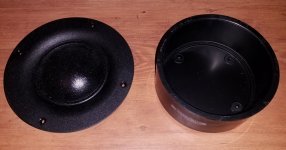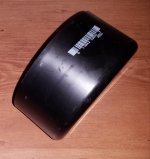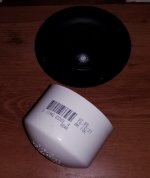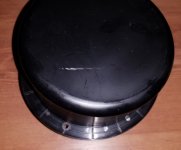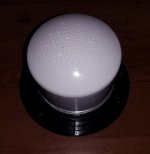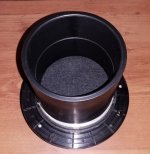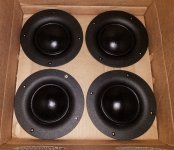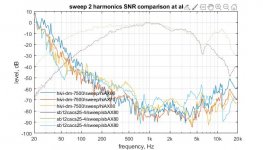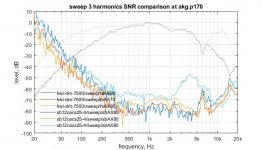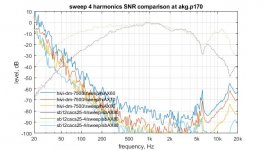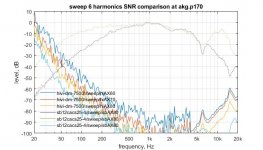I’m starting to think the market moved away from the 3” dome for a reason…
I see your point.
Making a large dome driver (the right way) is probably rather expensive (Volt, ATC, the new Bliesma). It seems like the only clear advantage they have over a small cone driver is sensitivity, and perhaps power handling. At the upper end of cost and performance, they may have a place.
As for the advantages of a small cone midrange (Sd of 40 - 80 cm^2), it is so much easier to deal with an Fs of 70 - 90 Hz rather than 350-450 Hz as is typical of dome mids.
That’s coz they are stuck with off the shelf/rack from manufacturers using products from the last century.
Have you seen Greg Begland; he’s ex DIYer
http://phatplanetstudios.com/
Have you seen Greg Begland; he’s ex DIYer
http://phatplanetstudios.com/
Well, I'm going to have to go out on a limb (not my own) and say that the D7608/D75MX41 is better than most people give it credit. PMC uses this mid and it sounds amazing in their monitors. I had a set of PMC IB1s which uses the D7608. It was a very musical speaker with lots of headroom and neutral presentation of vocals and acoustic instruments.I’m starting to think the market moved away from the 3” dome for a reason…
If you use the D7608 properly with the CORRECT REAR CHAMBER, it makes all the difference in its performance. It does have a considerable xmax limit, which will cause HD to rise quickly under 800 Hz, so you have to cross it just under 900 LR2 (or LR4) for best performance. That may be counterproductive for a 3" mid and dictates the use of a smaller bass mid (6 - 8" driver), but the music it makes in the sweet spot of 800 to 3.5k is quite exceptional. The driver itself doesn't look like anything special, but it just sings in a large 4 way or smaller 3+1 way (with subs). I built a set of 4 ways with SB34NRXL75 LF, Peerless NE180W-08, Scan Speak D7608 and Seas T35-C002. The D7608s were crossed at 900 and 3k LR2 and the T35-C002s were in a modified WG (originally designed for use with Audax TW034s).
The rear chamber on the D7608 has to be sized and dampened to get the Qtc down under 0.9 (very critical). This is achieved by overdampening the chamber right behind the felt disc. Thats the secret to getting the THD down around that area and make the low end rolloff more integrated with the bass mid. It will take more power this way not having the typical high Qtc. Using the mid "open baffle" never ends up well and sounds really blah. It needs the chamber. I use 4" pvc end caps from home depot stuffed with sheeps wool. The cap ID needs to be sanded open just a hair and attached with 3m weather strip cement. I recommend measuring Qtc first before gluing them on.
So these are some options you'll have. The 4" cap is ABS and the PVC version is what i used prior, but the manufacturer of these parts doesn't standardize the OD on these couplers or caps, so it depends on the batch you find, either at Lowes or HD. You just have to experiment and shop around sometimes. A place like Fergusons is also an option for plumbing parts.@profiguy do you have any photos of your D75 chamber? You've also mentioned you use an LCR circuit. Care to start a thread to document your build? It sounds very interesting.
There is the option of the 3" PVC end cap as well, which encompasses only the magnet itself and may not sound as good as the 4 " cap, which covers the terminals as well - on the 4" ABS version you'll need to notch out the terminal relief inside the ABS cap and drill a hole for wiring to terminals. A pigtail can be used for that, or crimp terminals if you're not as picky with the actual wire termination, as some people like to have a straight soldered connection only. The crimp terminals work just fine IMO and don't degrade the connection noticeably.
The 4" cap (depending on brand and wall thickness) will require some thinning on a bench grinder (very messy) to avoid intersecting the mounting holes on the necessary driver cutouts in the baffles. The 4" cap can also use a coupler extension with a 4" section of ABS pipe to lengthen it and create a back coupling that can be accessible by just removing the end cap. It will increase the chamber volume considerably, depending on the length you extend it with pipe section and require less stuffing to achieve a Qtc of 0.75 minimum. You must get the stuffing as close to the magnet felt disc as possible and not use too much stuffing density, otherwise it raises Fc and creates an undesirable double impedance hump (due restricting air flow and reducing direct air space behind the magnet vent holes). You'll have to experiment a little to get the stuffing density right and achieve the lowest Qtc and Fc at the same time.
Which option sounds best? IMO, the 4" ABS coupler / pipe section / end cap configuration sounds better than the 3" cap alone. Thats because the 3" cap only covers the magnet itself (encroaching the rear venting of the D7608 a little too much) and reduces chamber volume a little too much as well. That won't allow for a Qtc lower than 0.95 (based on my experimentation) and increases Fc a bit too much, depending on stuffing density. However, the 3" version can also employ a 3" coupler / pipe section / end cap configuration which increases chamber volume and allows the lowest Qtc of 0.75 and very low Fc with careful stuffing.
I have a text file somewhere with my notes, but I can't find it on my laptop yet - I have a long day tomorrow with 3 bass gigs back to back, so I need some extra sleep. I'll add this stuff as I can find it. Hope it's not too much info in one shot.
Attachments
Last edited:
Well, you have to admit that ATC mid dome is the pinnacle in mid dome engineering. The ATC stuff i listened to and worked with in the studio environment sounds remarkable for a large dome crossed around 400 hz. The driver itself has a motor assembly simikar in size of a decent sized pro woofer. Its a fantastic sounding driver and doesn't have much (if any) competition. The Bliesma 3" domes are out now but I haven't heard them yet to make a comparison. The Volt 3" dome isn't too far behind, but it has some phase weirdness in the upper mids that ii can't describe in words, putting it behind the ATC in performance.But the studio monitor cult aficionados say it is the only way to go!
ATC & VOLT ... and the search is over , your hobby is finished
I heard these A370 speakers at a show and was impressed. Very fast transient capability and coherent in the mids, alot like an ATC SM150 but a little cleaner and even more pleasant sounding (less forward). I could watch that video all day long. Alot of skilled labor going into that build. Very clean and methodical work ethic by these Europeans, although the French have to take an hour lunch break off the work premises by law... that would never fly over here. I admire the apparent clean and professional attitude in these workers.13:58
Is it not that dome driver Joachim Gherard uses in one of his Suesskindaudio loudspeaker but on the sides of a little tower ?
@profiguy, do you use active filtering to make this SS dome sounding flat from 900 to 3000 hz ? Could maybe an alternative for "poor man's OSMC Mbrewna loudspeaker with its 12pr320 woofer...
@profiguy, do you use active filtering to make this SS dome sounding flat from 900 to 3000 hz ? Could maybe an alternative for "poor man's OSMC Mbrewna loudspeaker with its 12pr320 woofer...
Last edited:
Also, hope not too much off topic for hificompass thread but my eyes are often lurking on this cone-doma sorta driver from SS audio division when it coles to find very flat smooth 1k to 3k response : 11M/4631G05 Gold... dome with a sounding cone wave guide...could be even better with inverted surroundings with very low Qms and wooden NSC material instead paper like the Discoverys' line.
Edit, JM semms to use OSB and chipboard with mdf in a CLD conf. Kef was using chipboard in his old ref line.
Edit, JM semms to use OSB and chipboard with mdf in a CLD conf. Kef was using chipboard in his old ref line.
Last edited:
No, those would be Peerless/Tymphany "domed" shallow format bass drivers:Is it not that dome driver Joachim Gherard uses in one of his Suesskindaudio loudspeaker but on the sides of a little tower ?
https://en.toutlehautparleur.com/media/catalog/product/datasheet/peerless/GBS-135F25AL02-04.pdf
Member
Joined 2003
The Peerless GBS, while low cost, isn't a true dome midrange as Draki points out, and it has high harmonic distortion products, likely from very little mechanical support to prevent rocking of the cone.
https://audioxpress.com/article/test-bench-tymphany-gbs-135f25al02-04-5-25-inch-woofer
https://audioxpress.com/article/test-bench-tymphany-gbs-135f25al02-04-5-25-inch-woofer
Sometimes we need to stop and ask ourselves the hard question- why do we need a 3" mid dome (apart from the ATC mid-dome being NLA)
I think it's the directivity mismatch between a LF device and HF device. In the traditional sense we want a driver to stitch the two together.
With the advent of waveguides, it can be done without the 3rd MF. eg. JBL M2.
The downside then, is the breakup in the top end of the pass band of a large (15") woofer: eg. 200Hz to 600Hz:
Exhibit A:

And then we have restricted top octave dispersion due to the waveguide (whether this is benefit, or hindrance, in real domestic rooms, is uncertain)

Compare that to a traditional 3 way, with a 5" midrange:
Note the flatter and smoother lower mids (250Hz to 500Hz)

Now look at a newer idea: A 3 way with a 2" flat piston driver, with a ribbon on top:
Note the flatter and smoother lower mids (250Hz to 500Hz) , and as well as the top 2 octaves (5-20KHz

And hence the overall polar response is wider.

Reference: www.erinsaudiocorner.com
The latter speaker is a 3 way with a 2" flat piston driver in the middle and a ribbon tweeter on top.
Now you're going to say "But JBL M2 is a much better speaker!"
It true it's a speaker with higher dynamic range for sure.
The main downside of this speaker is the wide-band used in the middle is low-moderate sensitivity.
When asked ,Tectonic Audio Labs have no interest making a high sensitivity version of this driver (they only seem interested in expanding their role/market in the small speaker/full-range market)
My argument is that what we'd like, in the marketplace is NOT a another uber-expensive 3" dome mid (with the dispersion of a 5-6" cone woofer), but a driver with better dispersion than a 5" midrange, with a high sensitivity.
I think it's the directivity mismatch between a LF device and HF device. In the traditional sense we want a driver to stitch the two together.
With the advent of waveguides, it can be done without the 3rd MF. eg. JBL M2.
The downside then, is the breakup in the top end of the pass band of a large (15") woofer: eg. 200Hz to 600Hz:
Exhibit A:
And then we have restricted top octave dispersion due to the waveguide (whether this is benefit, or hindrance, in real domestic rooms, is uncertain)
Compare that to a traditional 3 way, with a 5" midrange:
Note the flatter and smoother lower mids (250Hz to 500Hz)
Now look at a newer idea: A 3 way with a 2" flat piston driver, with a ribbon on top:
Note the flatter and smoother lower mids (250Hz to 500Hz) , and as well as the top 2 octaves (5-20KHz
And hence the overall polar response is wider.
Reference: www.erinsaudiocorner.com
The latter speaker is a 3 way with a 2" flat piston driver in the middle and a ribbon tweeter on top.
Now you're going to say "But JBL M2 is a much better speaker!"
It true it's a speaker with higher dynamic range for sure.
The main downside of this speaker is the wide-band used in the middle is low-moderate sensitivity.
When asked ,Tectonic Audio Labs have no interest making a high sensitivity version of this driver (they only seem interested in expanding their role/market in the small speaker/full-range market)
My argument is that what we'd like, in the marketplace is NOT a another uber-expensive 3" dome mid (with the dispersion of a 5-6" cone woofer), but a driver with better dispersion than a 5" midrange, with a high sensitivity.
Last edited:
I'm not sure what JBL have done with the M2 as it was tested by Erin but the crossover does not look the same as it does in their own measurements.The downside then, is the breakup in the top end of the pass band of a large (15") woofer: eg. 200Hz to 600Hz:
A 15" pro woofer should not be in break up at 200 to 500Hz and if you look at the measurements of the driver itself it is not.
https://manualzz.com/doc/37151866/eds-9990013-jbl-2216nd
Almost the same driver used in the 4367 with a passive crossover looks much flatter in that region in Erin's measurements. Most 15" drivers have some wiggle in the 500Hz region from cone/surround issues.
It is the size of the driver more so than the waveguide, the M2 has a 1.5" exit driver, a 1" driver would push this up but be less able to deliver as much SPL at the lower end.And then we have restricted top octave dispersion due to the waveguide (whether this is benefit, or hindrance, in real domestic rooms, is uncertain)
Yes you're onto something fluid.
The 4367 is flatter and smoother between 200hz and the crossover point.
Exhibit B: JBL 4367

Let's go on further and look at a speaker that is even smoother and flatter.
Exhibit C: metal cone MF, waveguided tweeter:

Note at 90 degrees it's 20dB down at 10Khz and 25dB down at 20Khz.
Here's the polar:

Let's circle back to the BMR:

If we accept the premise that the on-axis should be as flat and smooth as possible, and all other angles should be close replicas of the on-axis, but allowing for a inevitable downward tilt... what is the "correct" polar pattern?
Is the holy grail of loudspeakers is something that has (amongst other things) a flat and smooth response from 20Hz to 20KHz, in every direction?
In practice, in real rooms, what is the ideal dispersion pattern?
The 4367 is flatter and smoother between 200hz and the crossover point.
Exhibit B: JBL 4367
Let's go on further and look at a speaker that is even smoother and flatter.
Exhibit C: metal cone MF, waveguided tweeter:
Note at 90 degrees it's 20dB down at 10Khz and 25dB down at 20Khz.
Here's the polar:
Let's circle back to the BMR:
If we accept the premise that the on-axis should be as flat and smooth as possible, and all other angles should be close replicas of the on-axis, but allowing for a inevitable downward tilt... what is the "correct" polar pattern?
Is the holy grail of loudspeakers is something that has (amongst other things) a flat and smooth response from 20Hz to 20KHz, in every direction?
In practice, in real rooms, what is the ideal dispersion pattern?
Last edited:
I have come to the conclusion that there will never be a definitive answer to that question as there are too many other variables and preferences involved.In practice, in real rooms, what is the ideal dispersion pattern?
What is the ideal dispersion pattern? I used to think it depended on the room, but now I think that personal preference is the more important factor. It comes down to how much indirect sound does it take to make us satisfied. F.Toole pointed out that professional recording engineers and musicians prefer far less indirect sound than the average trained listener, so i.e. they prefer speakers with higher directivity.
- Home
- Loudspeakers
- Multi-Way
- Some speaker driver measurements...
